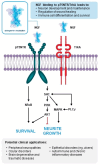The History of Nerve Growth Factor: From Molecule to Drug
- PMID: 38927039
- PMCID: PMC11201509
- DOI: 10.3390/biom14060635
The History of Nerve Growth Factor: From Molecule to Drug
Abstract
Nerve growth factor (NGF), the first neurotrophin to be discovered, has a long and eventful research journey with a series of turning points, setbacks, and achievements. Since the groundbreaking investigations led by Nobel Prize winner Rita Levi-Montalcini, advancements in the comprehension of NGF's functions have revolutionized the field of neuroscience, offering new insights and opportunities for therapeutic innovation. However, the clinical application of NGF has historically been hindered by challenges in determining appropriate dosing, administration strategies, and complications related to the production process. Recent advances in the production and scientific knowledge of recombinant NGF have enabled its clinical development, and in 2018, the United States Food and Drug Administration approved cenegermin-bkbj, a recombinant human NGF, for the treatment of all stages of neurotrophic keratitis. This review traces the evolutionary path that transformed NGF from a biological molecule into a novel therapy with potential research applications beyond the eye. Special emphasis is put on the studies that advanced NGF from discovery to the first medicinal product approved to treat a human disease.
Keywords: biomolecule; cenegermin; drug discovery; nerve growth factor; neurotrophic keratitis; neurotrophins.
Conflict of interest statement
Author Elizabeth Gavioli is employed by the company Dompé U.S. Inc. Authors Flavio Mantelli, Maria Candida Cesta, Marta Sacchetti and Marcello Allegretti are employed by the company Dompé farmaceutici S.p.A. The remaining authors declare that the research was conducted in the absence of any commercial or financial relationships that could be construed as a potential conflict of interest.
Figures


References
-
- Levi-Montalcini R. Elogio Dell’imperfezione. Baldini + Castoldi; Milan, Italy: 2013.
Publication types
MeSH terms
Substances
LinkOut - more resources
Full Text Sources

